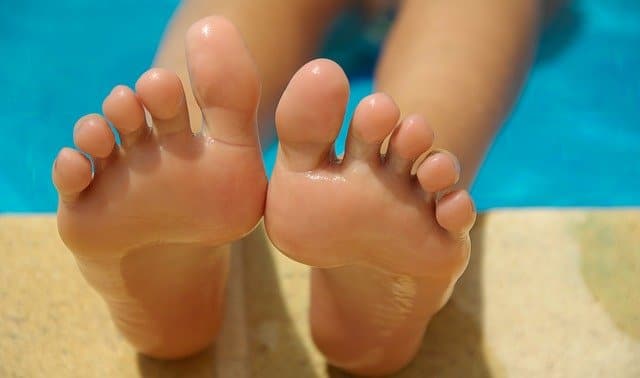Benefits of Exfoliating Feet & The Best Time To Start
When it comes to beauty regimens it’s easy to overlook your feet. Especially in the cooler months when they are hidden away in closed toed shoes and fluffy warm socks. Before you know it flip flop season arrives and calloused feet are ready to make their embarrassing appearance. Smooth feet can take weeks to achieve which is why the benefits of exfoliating feet regularly is huge! There are several easy options to keep this scenario at bay and incorporating a foot scrub or pumice stone into your shower routine would be an excellent place to start.

Materials
Exfoliating your feet can be done either chemically or manually.
Chemical foot peels work by inserting your feet into booties filled with enzymes or acids. These target only dead skin and work to break down the bonds which attach the layers of dead skin to your feet. If you haven’t heard of the Baby Foot Peel Mask – you’ve got to look it up! Beware – some of the images might give you the heebie-jeebies.
Manual exfoliation is done by products containing small particles or a textured surface that work by scrubbing away the dead skin. A few abrasive materials used for manual exfoliation would be:
– Cleansing Scrubs
– Exfoliating Mitts
– Dry Brushes
– Wash Cloth or Loofah
– Pumice Stone
– Foot File
Benefits of Exfoliating Feet
The benefits of exfoliating feet are proven to be one of the best preventative measures taken towards foot health. It’s important to recognize your feet are a vital corner stone to total body well being. Benefits include: smoother skin, treatment of painful rough callused patches, cracked heels and decreased chance of infection.
What Is Exfoliating?
Starting off with the basics, let’s be clear on what exfoliating is. Exfoliating is the process of removing dead skin cells from the surface of your skin. Your skin sheds skin cells about every 30 days and sometimes all the the dead cells do not fall off like they are supposed to. This can be due to a lack of moisture which easily can be caused from feet constantly being in closed shoes and socks. Hence the name “winter feet”. Skin not properly shedding is the cause of thick calluses and dry/ flaky patches. A regular care routine for your feet which includes regular exfoliation will ensure all of that dead skin does in fact shed off completely which leads to several benefits.
Smoother Skin
Caring for your feet doesn’t only keep calluses at bay but it helps to keep the texture of skin smooth. When dead skin doesn’t shed properly it builds into hard layers (calluses). This is when those pesky dry and cracked heels start. Moisture is unable to penetrate and therefore your skin doesn’t get the nourishment it needs. When heels get to the point of being dry and cracked, it means the skin barrier is disrupted. Which means your skin is loosing hydration, things can become inflamed and the risk of developing an infection increases. Exfoliating the skin is one of the fastest and simplest steps to introduce into your foot care routine to speed up results. A regular care routine of your feet should include keeping your feet exfoliated, clean and moisturized.
Regular Care Routine For Your Feet
It can take weeks to mend your feet into a soft and healthy status but once your feet are there – it’s pretty simple to maintain. (It is worth noting that it’s important to see a professional if you are not able to recover your dry and cracked feet.)

Here is the best way to achieve and maintain your prettiest twinkle toes:
1. Soak
The best way to maximize the benefits of exfoliating your feet is to start off by soaking them in warm water for 5-15 minutes. Adding in Epsom salt is an excellent way to give your feet an extra boost as it helps rid toxins from the body. Soaking your feet twice a week is the perfect amount to show your feet a little TLC and keep them looking their best.
2. Exfoliate
Directly after their soak is the best time to scrub away the dead skin. Be sure you’re not too aggressive with this step. If you have a build up of dead skin it takes time to wear it down and if you try removing a large callus in one sitting you risk creating sores or an injury. If you continue a regular care routine for your feet the baby soft feeling will come.
3. Moisturize
The most important step after exfoliation is adding moisture back into the skin. DO NOT FORGET TO DO THIS! An awesome way to maximize lotion penetration is to apply every night before bed. A good ingredient to look for in your foot lotion is Urea of at least 20%. It’s a powerful ingredient which has the ability to pass through the outer layer of skin. It enhances water absorption which in return helps the skin to retain water.
4. Seal It In
As a final step, it’s a great idea to seal all of those skin loving and moisture boosting ingredients into your skin be adding a barrier. Wearing socks to bed or adding a layer of an occlusive ointment helps make sure none of the good stuff can escape. I personally can not stand wearing socks to bed so I like to add a layer of Aquaphor over my lotion.
5. Protect
I often feel feet are neglected in the sunscreen application. The skin on top of our feet is thin and delicate. It’s important to protect feet from the sun so they don’t get burned. Sunburnt skin can lead to dry/peeling skin and that’s exactly what we are trying to eliminate.
All in all, the best time to start on your regular care routine for your feet is now!
Getting your feet ready for summer can take time. I would suggest starting at least 1.5 months before summer hits in order to really see the benefits of exfoliating feet regularly. That way when it’s time for your tootsies to come out of hibernation they will be ready!
Dry skin doesn’t only happen on our feet. While you are already in the process of making your feet feel the softest they can hop over and read the importance of exfoliating your entire body and the best practices to easily transform all of your skin!


